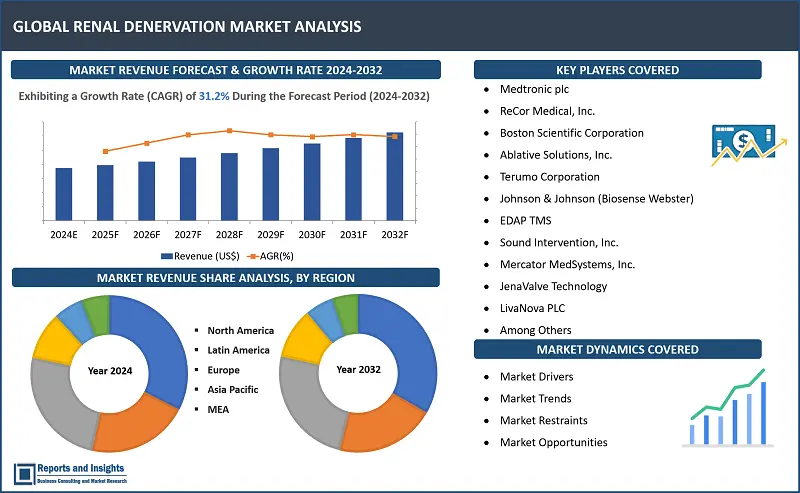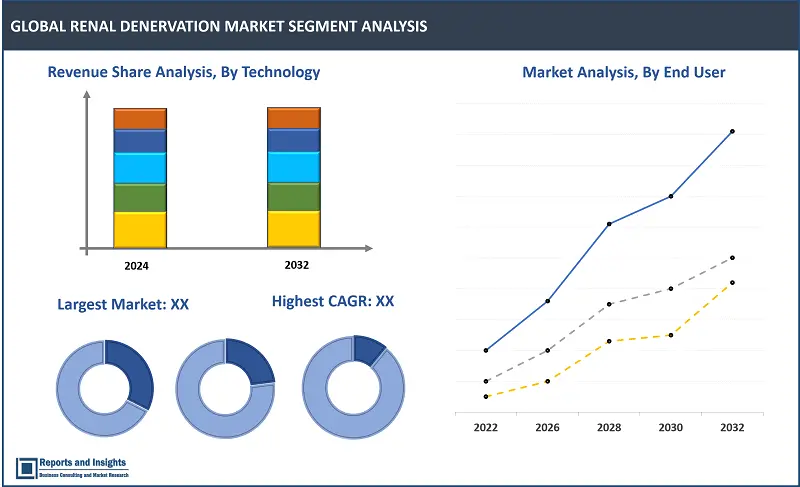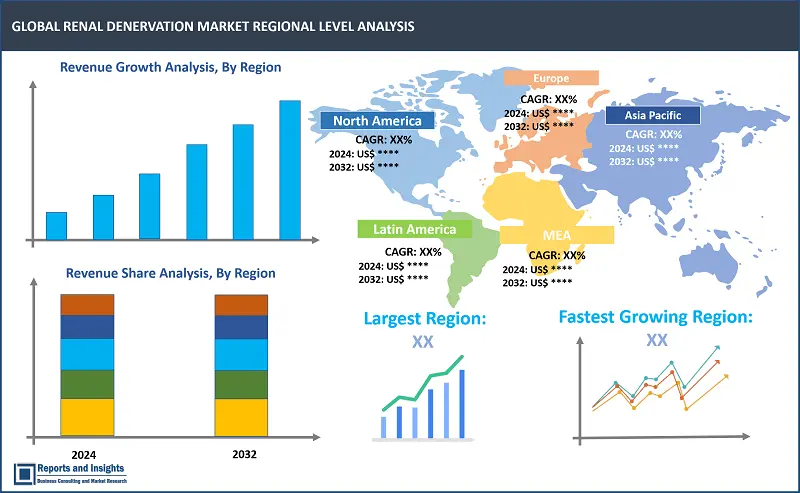Market Overview:
"The renal denervation market was valued at US$ 350.4 million in 2023, and is expected to register a CAGR of 31.2% over the forecast period and reach US$ 4,036.2 million in 2032."
|
Report Attributes |
Details |
|
Base Year |
2023 |
|
Forecast Years |
2024-2032 |
|
Historical Years |
2021-2023 |
|
Renal Denervation Market Growth Rate (2024-2032) |
31.2% |
Renal Denervation (RDN), also known as renal ablation, is a minimally-invasive investigational medical procedure to treat hyper tension or high blood pressure in patients who have shown no signs of improvement after being treated with other conventional approaches and treatments. Some known causes of treatment-resistant hypertension include physician inertia, inadequate doses or inappropriate combinations of antihypertensive drugs, poor patient adherence, excess alcohol intake, and volume overload.
RDN procedures entail disruption of renal nerves to manage conditions such as resistant hypertension and other cardiovascular diseases, using radiofrequency ablation, ultrasound, and other approaches to target and interrupt signals to the sympathetic nerves that connect the kidneys and the brain in order to regulate blood pressure and glycaemic control, and improve cardiovascular health.
A increasing number of individuals report suffering from hypertension and while some may be able to leverage the benefits of traditional antihypertensive medications, for some this may prove ineffective. RDN is an alternative approach for patients who are unable to control blood pressure through more standard approaches, and need to seek an alternative to reduce the potential risks of complications and/or stroke or heart attack. Renal denervation can be performed using different techniques, including radiofrequency ablation in which heat is employed to damage the nerves, and ultrasound in which sound waves are used to the similar effect. The procedure is minimally-invasive and relatively quick to perform, typically via catheterization.
Various techniques are employed in renal denervation, including radiofrequency ablation, where heat is used to damage the nerves, and ultrasound, which uses sound waves for a similar effect. These methods are minimally invasive and relatively quick, and are typically performed via catheterization through a small incision under local aesthesia and conscious sedation to reduce pain. Each denervation ablation lasts 60 seconds, and two ablations are applied at different locations in the same renal artery. RDN takes around an hour and patients typically have a short hospital stay and quick recovery with less pain.
Advancements in technology and medical techniques has been resulting in enhanced patient safety and effectiveness of various procedures, and RDN is also being explored for treating chronic kidney disease, heart failure, and metabolic disorders, among others.

Renal Denervation Market Trends and Drivers:
Hypertension has been indicating a substantial incline in current-day populations of varying ages, and prevalence continues to rise alarmingly as a result of factors including age and lifestyle risks. Age and age-related diseases and conditions are primary among the key factors, and as individuals age, the blood vessels thicken and this can cause a number of health issues. Genetics has proven to be hereditary and can affect others in the family. Obesity has also been increasing, especially among younger individuals, and this can pose risks of developing high blood pressure. Sedentary lifestyle is also a cause of health issues and conditions, and lack of physical activity can increase the risk of developing high blood pressure. High-salt diet can also cause high blood pressure, and excessive alcohol consumption is also a major and high risk factor for developing BP. In addition, health conditions such as diabetes can increase the risk of developing high blood pressure.
The current trend is an increasing number of individuals are opting for regular medical and health check-ups, resulting in the trend of preventive healthcare gaining traction. Also, increased accessibility and availability of more modern healthcare facilities and services has been serving to identify and treat individuals with this condition, especially in some developing countries. Along with the mentioned factors driving rising prevalence of treatment-resistant hypertension, work stress, mental pressure, and emotional triggers are known to cause hypertension and chronic conditions over the long term. Rising prevalence of treatment-resistant hypertension is necessitating alternative solutions as traditional medications and approaches are proving ineffective for some patients. Renal denervation is being sought by more individuals as an effective approach for managing BP, reducing risk and complications of cardiovascular complications, and this is to a major extent being driven by increasing awareness among healthcare professionals and patients about the benefits of RDN.
In addition, renal denervation has been expanding beyond the limits of resistant hypertension, and is being explored for potential benefits in treating chronic kidney disease, heart failure, and metabolic disorders, and this is expected to have a positive impact on renal denervation market growth going ahead. Research and Development (R&D) initiatives to advance the potential of RDN has been leading to improvements in precision, safety, and efficacy of this technique, and innovations such as catheter-based and multi-electrode radiofrequency devices in development to enhance outcomes of these procedures and improve patient safety.
RDN has also been gaining preference owing to the minimally-invasive nature, shorter recovery times, and compatibility with existing treatment regimens. Also, the effectiveness of RDN is being validated, and an increasing number of healthcare providers are recommending the procedure for eligible patients and individuals, and this is a trend that is supporting demand. Moreover, regulatory approvals and favorable reimbursement policies for such procedures in some countries is supporting adoption and preference for these procedures to address resistant hypertension.
Renal Denervation Market Restraining Factors:
Renal denervation does have its advantages and benefits, but while some studies show positive results and outcomes, others have remained less conclusive, and this can lead to uncertainty regarding the long-term effectiveness of the procedure. Lack of long-term data and any variability in study results can result in both, patients and healthcare providers maintaining a cautious approach in opting for or recommending RDN as a standard treatment option. In addition, high cost is a factor for some patients and healthcare facilities, and in some regions and economies, as the costs include specialized equipment and skilled professionals. Also, this can be more pronounced in countries with lack of comprehensive insurance coverage or if the rates are low.
Other key factors are regulatory challenges and stringent safety norms, because as with any medical procedure or device, renal denervation must meet rigorous standards that ensure patient safety and equipment efficacy. In some regions and countries, obtaining regulatory approvals can take time, and can be a costly process, thereby delaying the introduction of new technologies and applications in the market. Availability of alternative treatments to manage symptoms, such as using unconventional medicines or substances, lifestyle changes, and other approaches can delay the urgency in seeking RDN. For others, potential side effects of the procedure such as vascular damage or renal impairment can deter a positive decision and expected to affect the demand for renal denervation.
Renal Denervation Market Player Opportunities:
Safety and efficacy will always remain major concerns, and can be further addressed by development of innovative technologies to ensure renal denervation procedures meet the prerequisites in terms of safety and efficacy. Research and development (R&D) investments can enable companies to design new devices and techniques that offer improved outcomes and gain trust among more healthcare providers and patients.
Expanding into emerging markets will also serve to enable companies to cater to rising demand for advanced medical procedures, especially in countries in regions with expanding healthcare infrastructure and increasing investment in the sector, such as Asia Pacific and Latin America.
Collaborations and partnerships are also lucrative strategies to engage in with research institutions and medical organizations and work with experts in the field, and gain access to valuable data and insights to enable informed product development and assist in clinical trials. This approach can serve to develop more effective treatments, broaden the potential applications of RDN, and open up new revenue streams. In addition, diversifying applications beyond hypertension such as into treatment of chronic kidney disease, heart failure, and metabolic disorders can open up further potential.
Renal Denervation Market Segmentation:

By Technology
- Radiofrequency Ablation
- Ultrasound Ablation
- Microwaves Ablation
- Other Technologies
The radiofrequency ablation segment is expected to account for the largest revenue share in the renal denervation market over the forecast period. This projection is supported by the extensive clinical research supporting efficacy and safety of this type of ablation, making it the most established and widely adopted approach. In addition, the use of radiofrequency ablation is well understood by healthcare professionals, who are already familiar with the technique from other medical applications. Being minimally-invasive in nature and having a proven track record in blood pressure management, this procedure is expected to continue to maintain dominance over other technologies and drive a register a steady growth incline.
By Application
- Resistant Hypertension
- Heart Failure
- Chronic Kidney Disease
- Metabolic Disorders
Among the application segments, the resistant hypertension segment is expected to account for the largest revenue share, driven by the high prevalence of resistant hypertension worldwide and the growing need for alternative treatments when standard medications are ineffective. Renal denervation provides a promising solution for managing blood pressure in these patients, offering significant improvements in cardiovascular health. The procedure's proven efficacy in clinical trials and its potential to reduce healthcare costs associated with unmanaged hypertension further drive its adoption and revenue growth.
By End User
- Hospitals
- Ambulatory Surgical Centers
- Specialty Clinics
- Research and Academic Institutes
The hospitals segment is expected to account for the largest revenue share over the forecast period, and this can be attributed to advanced infrastructure availability and access to cutting-edge medical technologies, thereby enabling hospitals to provide renal denervation procedures safely and effectively. Hospitals also typically have specialized departments and trained professionals, making these settings the preferred choice for patients seeking treatment for any conditions. The central role of hospitals in healthcare delivery, along with ability to handle complex cases, further justifies the projected revenue growth of this segment.
By Product Type
- Single Electrode Catheters
- Multi-Electrode Catheters
- Non-Invasive Devices
- Other Products
Among the product type segments, the single electrode catheters segment is expected to account for the largest revenue share. Established effectiveness and safety of single electrode catheters in performing renal denervation procedures are key factors supporting this projection. These catheters provide precise control and targeted ablation of renal nerves, leading to reliable outcomes, and single electrode catheters are also widely used in clinical practice and healthcare professionals are familiar with usage. Also, relatively lower cost compared to multi-electrode catheters supports broader use.
By Region

North America
- United States
- Canada
Europe
- Germany
- United Kingdom
- France
- Italy
- Spain
- Russia
- Poland
- Benelux
- Nordic
- Rest of Europe
Asia Pacific
- China
- Japan
- India
- South Korea
- ASEAN
- Australia & New Zealand
- Rest of Asia Pacific
Latin America
- Brazil
- Mexico
- Argentina
Middle East & Africa
- Saudi Arabia
- South Africa
- United Arab Emirates
- Israel
- Rest of MEA
The global Renal Denervation Market is divided into five key regions: North America, Europe, Asia Pacific, Latin America, and the Middle East and Africa. Among these, North America is the leading regional market, driven primarily by high prevalence rates of treatment-resistant hypertension, strong healthcare infrastructure, and robust research and development initiatives. The United States (US) leads in North America due to early adoption of advanced medical technologies and access to leading companies in the industry.
In Europe, countries such as Germany and the United Kingdom (UK) are at the forefront, with strong healthcare systems and supportive regulatory environments facilitating the adoption of renal denervation. High awareness among medical professionals and patients about the procedure's benefits also contributes to growth in this region. In Asia-Pacific, countries such as Japan and China are emerging as key markets due to large populations and increasing healthcare investments. Improved access to medical devices and growing awareness of renal denervation are also supporting market growth. Some common factors driving overall growth in these regions include rising prevalence of resistant hypertension, advancements in renal denervation technologies, and increase in clinical evidence supporting the safety and efficacy of the procedure.
Leading Companies in Renal Denervation Market & Competitive Landscape:
The competitive landscape in the global renal denervation market is marked by the presence of leading companies such as Medtronic, Boston Scientific, and ReCor Medical, each vying to gain renal denervation market share through innovative technologies and strategic partnerships. Companies are focusing on research and development to create more efficient, safe, and cost-effective renal denervation solutions. These advances help to improve clinical outcomes and expand the range of conditions treated by renal denervation.
To maintain their position and expand their consumer base, leading companies are adopting several key strategies. These include strategic acquisitions and collaborations to strengthen their product portfolios and accelerate the development of new technologies. Companies are also investing in clinical trials and studies to validate the safety and efficacy of their renal denervation products, gaining trust from healthcare providers and regulatory bodies.
In addition, companies are focusing on expanding their global footprint, particularly in emerging markets where the demand for advanced medical treatments is rising. By tailoring their offerings to regional needs and strengthening distribution networks, leading players aim to capture a larger share of the global renal denervation market.
These companies include:
- Medtronic plc
- ReCor Medical, Inc.
- Boston Scientific Corporation
- Ablative Solutions, Inc.
- Terumo Corporation
- Johnson & Johnson (Biosense Webster)
- EDAP TMS
- Sound Intervention, Inc.
- Mercator MedSystems, Inc.
- JenaValve Technology
- LivaNova PLC
- Terumo Corporation
- Koninklijke Philips N.V.
- Abbott Laboratories
- Cordis
Recent Developments:
- December 2023: India Medtronic, which is a fully owned subsidiary of Medtronic plc based in Ireland, introduced the Symplicity Spyral renal denervation system (RDN) for managing high blood pressure. RDN is a minimally invasive therapy that targets nerves near the kidneys that may become overactive and lead to elevated blood pressure. Medtronic recently obtained approval from the US Food and Drug Administration (FDA) for the system, marking the end of a decade of clinical research and development. The system has also gained clearance from Indian regulatory authorities. In November 2023, Medtronic announced the successful completion of the first commercial case in the U.S. using its Symplicity Spyral renal denervation (RDN) system.
- November 2023: ReCor Medical announced the initial commercial applications of its Paradise ultrasound renal denervation (uRDN) system for treating hypertension. This follows the company’s milestone FDA approval for Paradise, which was granted last week. The approval enables the use of Paradise as a supplementary treatment option when lifestyle modifications and medications do not sufficiently manage a patient's blood pressure.
Renal Denervation Market Research Scope
|
Report Metric |
Report Details |
|
Renal Denervation Market Size available for the Years |
2021-2023 |
|
Base Year |
2023 |
|
Forecast Period |
2024-2032 |
|
Compound Annual Growth Rate (CAGR) |
31.2% |
|
Segments Covered |
Technology, Application, End User, Product Type |
|
Regions Covered |
North America: The U.S. & Canada Latin America: Brazil, Mexico, Argentina, & Rest of Latin America Asia Pacific: China, India, Japan, Australia & New Zealand, ASEAN, & Rest of Asia Pacific Europe: Germany, The U.K., France, Spain, Italy, Russia, Poland, BENELUX, NORDIC, & Rest of Europe The Middle East & Africa: Saudi Arabia, United Arab Emirates, South Africa, Egypt, Israel, and Rest of MEA |
|
Fastest Growing Country in Europe |
The U.K. |
|
Largest Market |
North America |
|
Key Players |
Medtronic plc, ReCor Medical, Inc., Boston Scientific Corporation, Ablative Solutions, Inc., Terumo Corporation, Johnson & Johnson (Biosense Webster), EDAP TMS, Sound Intervention, Inc., Mercator MedSystems, Inc., JenaValve Technology, LivaNova PLC, Terumo Corporation, Koninklijke Philips N.V., Abbott Laboratories, Cordis |
Frequently Asked Question
What is the size of the global renal denervation market in 2023?
The global renal denervation market size reached US$ 350.4 million in 2023.
At what CAGR will the global renal denervation market expand?
The global market is expected to register a 31.2% CAGR through 2024-2032.
Who are leaders in the renal denervation market?
Medtronic plc, Boston Scientific Corporation, and ReCor Medical, Inc. are known for their innovative technologies and broad market presence, and their expertise, extensive research and development efforts, and strategic partnerships contribute to their leading positions in the market.
What are some key factors driving revenue growth of the renal denervation market?
Rising prevalence of treatment-resistant hypertension, increasing awareness of the procedure's benefits, and advancements in technology that enhance safety and efficacy.
What are some major challenges faced by companies in the renal denervation market?
Major challenges faced by companies in the renal denervation market include regulatory hurdles, as stringent safety and efficacy standards must be met for approval.
How is the competitive landscape in the renal denervation market?
The competitive landscape in the renal denervation market is characterized by several major players with strong research and development capabilities. Companies compete on technology innovation, product safety and efficacy, and strategic partnerships.
How is the renal denervation market report segmented?
The renal denervation market report is segmented based technology, application, end user, product type, and region
Who are the key players in the renal denervation market report?
Medtronic plc, ReCor Medical, Inc., Boston Scientific Corporation, Ablative Solutions, Inc., Terumo Corporation, Johnson & Johnson (Biosense Webster), EDAP TMS, Sound Intervention, Inc., Mercator MedSystems, Inc., JenaValve Technology, LivaNova PLC, Terumo Corporation, Koninklijke Philips N.V., Abbott Laboratories, and Cordis

